Yanyang Li
C$^2$LEVA: Toward Comprehensive and Contamination-Free Language Model Evaluation
Dec 06, 2024Abstract:Recent advances in large language models (LLMs) have shown significant promise, yet their evaluation raises concerns, particularly regarding data contamination due to the lack of access to proprietary training data. To address this issue, we present C$^2$LEVA, a comprehensive bilingual benchmark featuring systematic contamination prevention. C$^2$LEVA firstly offers a holistic evaluation encompassing 22 tasks, each targeting a specific application or ability of LLMs, and secondly a trustworthy assessment due to our contamination-free tasks, ensured by a systematic contamination prevention strategy that fully automates test data renewal and enforces data protection during benchmark data release. Our large-scale evaluation of 15 open-source and proprietary models demonstrates the effectiveness of C$^2$LEVA.
Making Long-Context Language Models Better Multi-Hop Reasoners
Aug 06, 2024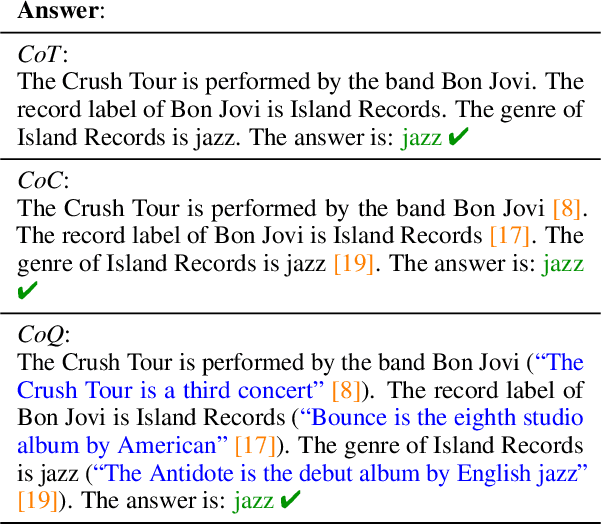
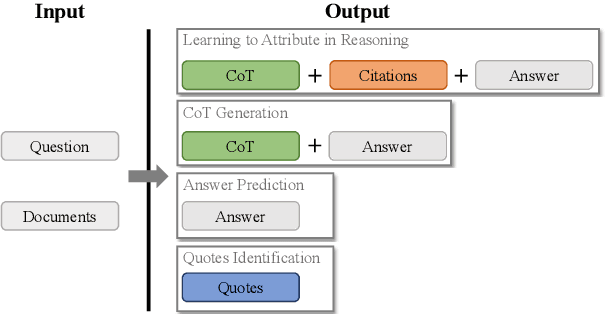
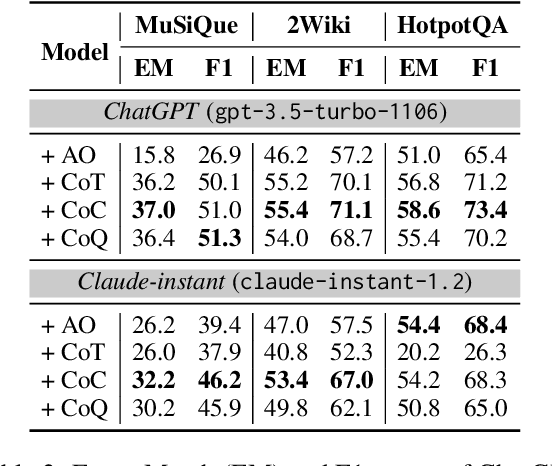

Abstract:Recent advancements in long-context modeling have enhanced language models (LMs) for complex tasks across multiple NLP applications. Despite this progress, we find that these models struggle with multi-hop reasoning and exhibit decreased performance in the presence of noisy contexts. In this paper, we introduce Reasoning with Attributions, a novel approach that prompts LMs to supply attributions for each assertion during their reasoning. We validate our approach through experiments on three multi-hop datasets, employing both proprietary and open-source models, and demonstrate its efficacy and resilience. Furthermore, we explore methods to augment reasoning capabilities via fine-tuning and offer an attribution-annotated dataset and a specialized training strategy. Our fine-tuned model achieves competitive performance on multi-hop reasoning benchmarks, closely paralleling proprietary LMs such as ChatGPT and Claude-instant.
VL-PET: Vision-and-Language Parameter-Efficient Tuning via Granularity Control
Aug 18, 2023Abstract:As the model size of pre-trained language models (PLMs) grows rapidly, full fine-tuning becomes prohibitively expensive for model training and storage. In vision-and-language (VL), parameter-efficient tuning (PET) techniques are proposed to integrate modular modifications (e.g., Adapter and LoRA) into encoder-decoder PLMs. By tuning a small set of trainable parameters, these techniques perform on par with full fine-tuning. However, excessive modular modifications and neglecting the functionality gap between the encoders and decoders can lead to performance degradation, while existing PET techniques (e.g., VL-Adapter) overlook these critical issues. In this paper, we propose a Vision-and-Language Parameter-Efficient Tuning (VL-PET) framework to impose effective control over modular modifications via a novel granularity-controlled mechanism. Considering different granularity-controlled matrices generated by this mechanism, a variety of model-agnostic VL-PET modules can be instantiated from our framework for better efficiency and effectiveness trade-offs. We further propose lightweight PET module designs to enhance VL alignment and modeling for the encoders and maintain text generation for the decoders. Extensive experiments conducted on four image-text tasks and four video-text tasks demonstrate the efficiency, effectiveness and transferability of our VL-PET framework. In particular, our VL-PET-large with lightweight PET module designs significantly outperforms VL-Adapter by 2.92% (3.41%) and LoRA by 3.37% (7.03%) with BART-base (T5-base) on image-text tasks. Furthermore, we validate the enhanced effect of employing our VL-PET designs on existing PET techniques, enabling them to achieve significant performance improvements. Our code is available at https://github.com/HenryHZY/VL-PET.
CLEVA: Chinese Language Models EVAluation Platform
Aug 09, 2023



Abstract:With the continuous emergence of Chinese Large Language Models (LLMs), how to evaluate a model's capabilities has become an increasingly significant issue. The absence of a comprehensive Chinese benchmark that thoroughly assesses a model's performance, the unstandardized and incomparable prompting procedure, and the prevalent risk of contamination pose major challenges in the current evaluation of Chinese LLMs. We present CLEVA, a user-friendly platform crafted to holistically evaluate Chinese LLMs. Our platform employs a standardized workflow to assess LLMs' performance across various dimensions, regularly updating a competitive leaderboard. To alleviate contamination, CLEVA curates a significant proportion of new data and develops a sampling strategy that guarantees a unique subset for each leaderboard round. Empowered by an easy-to-use interface that requires just a few mouse clicks and a model API, users can conduct a thorough evaluation with minimal coding. Large-scale experiments featuring 23 influential Chinese LLMs have validated CLEVA's efficacy.
Multi-Path Transformer is Better: A Case Study on Neural Machine Translation
May 10, 2023



Abstract:For years the model performance in machine learning obeyed a power-law relationship with the model size. For the consideration of parameter efficiency, recent studies focus on increasing model depth rather than width to achieve better performance. In this paper, we study how model width affects the Transformer model through a parameter-efficient multi-path structure. To better fuse features extracted from different paths, we add three additional operations to each sublayer: a normalization at the end of each path, a cheap operation to produce more features, and a learnable weighted mechanism to fuse all features flexibly. Extensive experiments on 12 WMT machine translation tasks show that, with the same number of parameters, the shallower multi-path model can achieve similar or even better performance than the deeper model. It reveals that we should pay more attention to the multi-path structure, and there should be a balance between the model depth and width to train a better large-scale Transformer.
SPRING: Situated Conversation Agent Pretrained with Multimodal Questions from Incremental Layout Graph
Jan 05, 2023



Abstract:Existing multimodal conversation agents have shown impressive abilities to locate absolute positions or retrieve attributes in simple scenarios, but they fail to perform well when complex relative positions and information alignments are involved, which poses a bottleneck in response quality. In this paper, we propose a Situated Conversation Agent Petrained with Multimodal Questions from INcremental Layout Graph (SPRING) with abilities of reasoning multi-hops spatial relations and connecting them with visual attributes in crowded situated scenarios. Specifically, we design two types of Multimodal Question Answering (MQA) tasks to pretrain the agent. All QA pairs utilized during pretraining are generated from novel Incremental Layout Graphs (ILG). QA pair difficulty labels automatically annotated by ILG are used to promote MQA-based Curriculum Learning. Experimental results verify the SPRING's effectiveness, showing that it significantly outperforms state-of-the-art approaches on both SIMMC 1.0 and SIMMC 2.0 datasets.
Eliciting Knowledge from Large Pre-Trained Models for Unsupervised Knowledge-Grounded Conversation
Nov 08, 2022



Abstract:Recent advances in large-scale pre-training provide large models with the potential to learn knowledge from the raw text. It is thus natural to ask whether it is possible to leverage these large models as knowledge bases for downstream tasks. In this work, we answer the aforementioned question in unsupervised knowledge-grounded conversation. We explore various methods that best elicit knowledge from large models. Our human study indicates that, though hallucinations exist, large models post the unique advantage of being able to output common sense and summarize facts that cannot be directly retrieved from the search engine. To better exploit such generated knowledge in dialogue generation, we treat the generated knowledge as a noisy knowledge source and propose the posterior-based reweighing as well as the noisy training strategy. Empirical results on two benchmarks show advantages over the state-of-the-art methods.
On Effectively Learning of Knowledge in Continual Pre-training
Apr 17, 2022
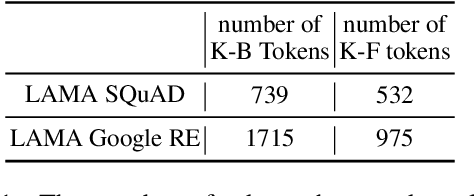
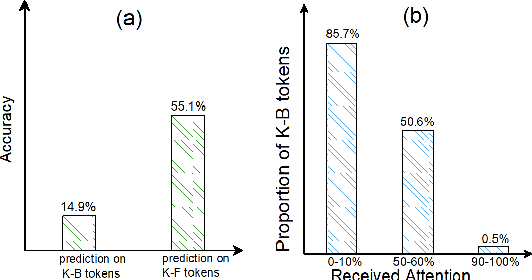
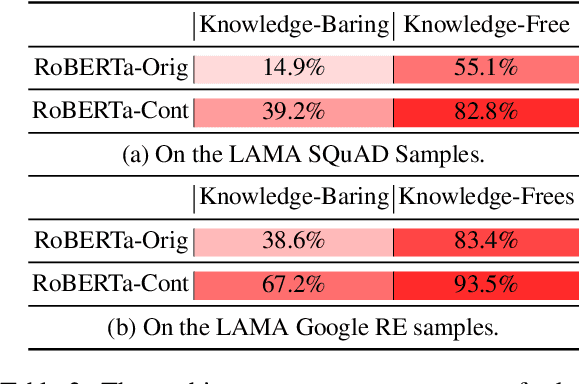
Abstract:Pre-trained language models (PLMs) like BERT have made significant progress in various downstream NLP tasks. However, by asking models to do cloze-style tests, recent work finds that PLMs are short in acquiring knowledge from unstructured text. To understand the internal behaviour of PLMs in retrieving knowledge, we first define knowledge-baring (K-B) tokens and knowledge-free (K-F) tokens for unstructured text and ask professional annotators to label some samples manually. Then, we find that PLMs are more likely to give wrong predictions on K-B tokens and attend less attention to those tokens inside the self-attention module. Based on these observations, we develop two solutions to help the model learn more knowledge from unstructured text in a fully self-supervised manner. Experiments on knowledge-intensive tasks show the effectiveness of the proposed methods. To our best knowledge, we are the first to explore fully self-supervised learning of knowledge in continual pre-training.
Probing Structured Pruning on Multilingual Pre-trained Models: Settings, Algorithms, and Efficiency
Apr 06, 2022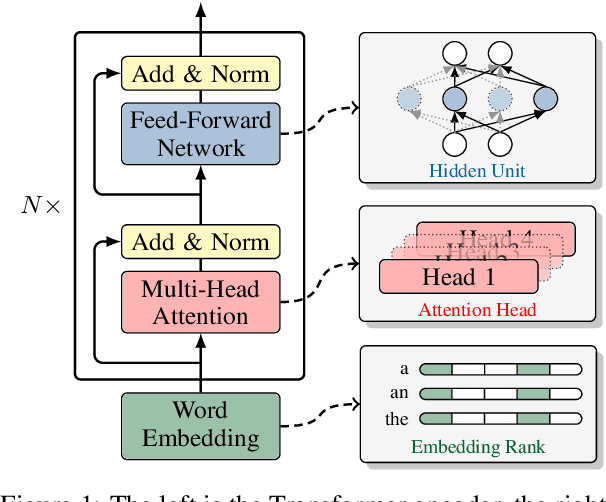
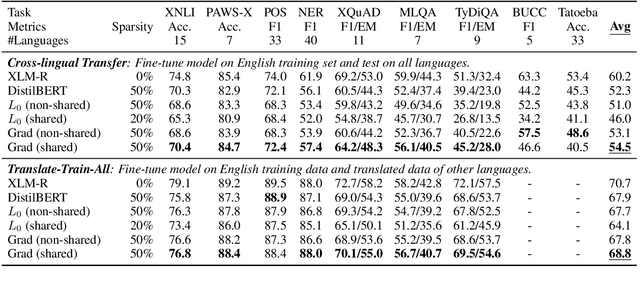

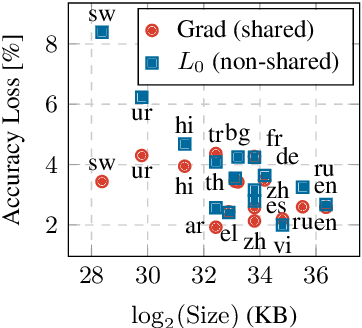
Abstract:Structured pruning has been extensively studied on monolingual pre-trained language models and is yet to be fully evaluated on their multilingual counterparts. This work investigates three aspects of structured pruning on multilingual pre-trained language models: settings, algorithms, and efficiency. Experiments on nine downstream tasks show several counter-intuitive phenomena: for settings, individually pruning for each language does not induce a better result; for algorithms, the simplest method performs the best; for efficiency, a fast model does not imply that it is also small. To facilitate the comparison on all sparsity levels, we present Dynamic Sparsification, a simple approach that allows training the model once and adapting to different model sizes at inference. We hope this work fills the gap in the study of structured pruning on multilingual pre-trained models and sheds light on future research.
FlowEval: A Consensus-Based Dialogue Evaluation Framework Using Segment Act Flows
Feb 14, 2022Abstract:Despite recent progress in open-domain dialogue evaluation, how to develop automatic metrics remains an open problem. We explore the potential of dialogue evaluation featuring dialog act information, which was hardly explicitly modeled in previous methods. However, defined at the utterance level in general, dialog act is of coarse granularity, as an utterance can contain multiple segments possessing different functions. Hence, we propose segment act, an extension of dialog act from utterance level to segment level, and crowdsource a large-scale dataset for it. To utilize segment act flows, sequences of segment acts, for evaluation, we develop the first consensus-based dialogue evaluation framework, FlowEval. This framework provides a reference-free approach for dialog evaluation by finding pseudo-references. Extensive experiments against strong baselines on three benchmark datasets demonstrate the effectiveness and other desirable characteristics of our FlowEval, pointing out a potential path for better dialogue evaluation.
 Add to Chrome
Add to Chrome Add to Firefox
Add to Firefox Add to Edge
Add to Edge